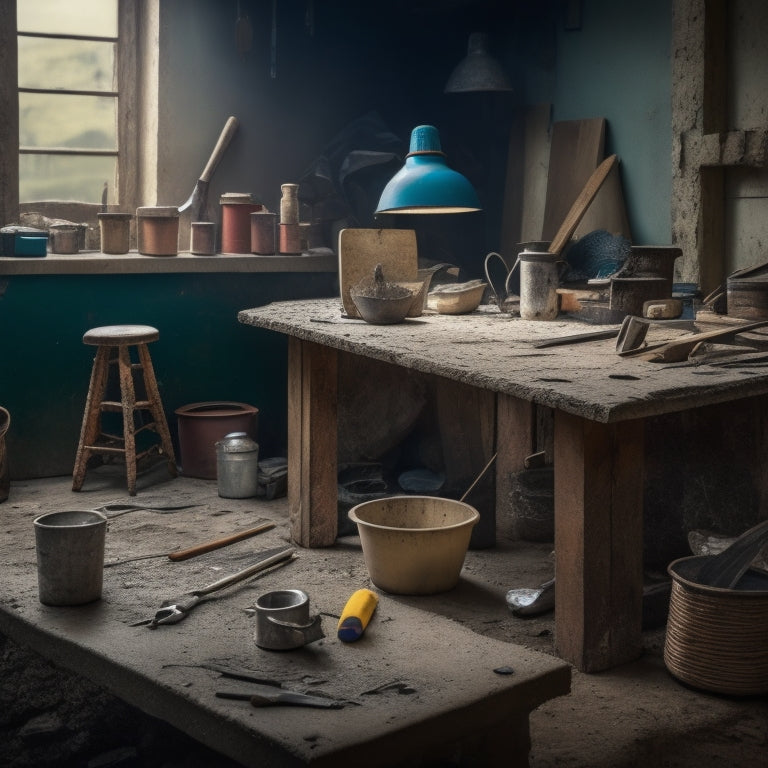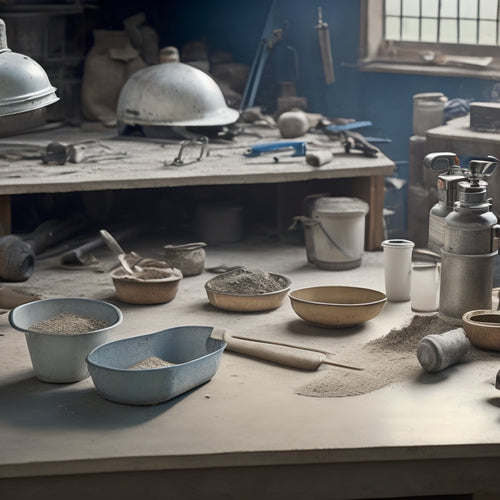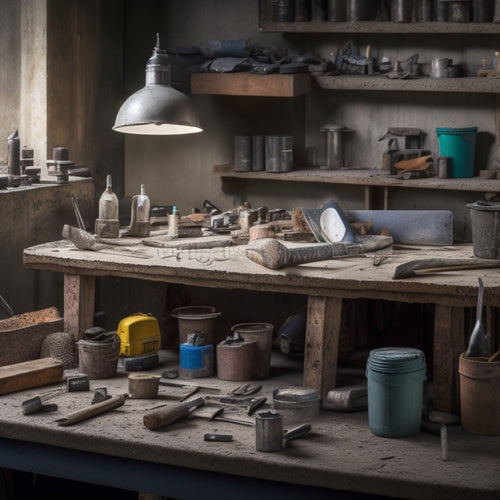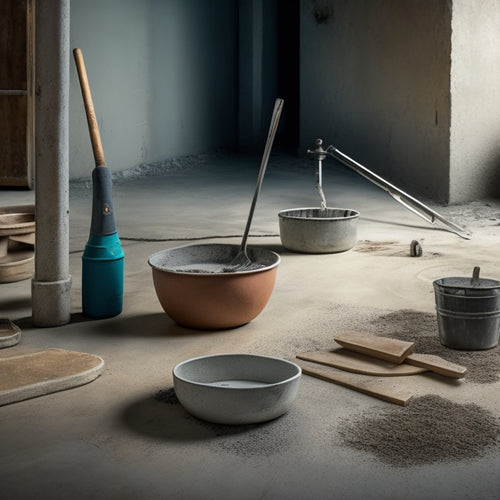
Why You Need These Tools for Concrete Wall Repair
Share
You'll need a thorough set of specialized tools to guarantee a successful concrete wall repair, as a lack of proper equipment can lead to structural weaknesses, compromised adhesion, and a failed repair. From essential drilling and mixing tools to tamping and compacting equipment, each plays a vital role in achieving a strong and durable bond. Safety gear, cutting and chiseling tools, bonding materials, and finishing instruments are also essential for a professional-grade repair. With the right tools, you'll be able to tackle complex repairs with confidence and precision - and discover the specific techniques and strategies that will take your skills to the next level.
Key Takeaways
• Accurate drilling and mixing techniques ensure a strong, durable concrete bond, making the right tools essential for a successful repair.
• Proper surface preparation, including cleaning and etching, guarantees a strong bond between old and new concrete.
• Tamping and compacting tools are necessary to densify the concrete, preventing premature repair failure.
• Safety gear, such as protective eyewear and gloves, is crucial to prevent injuries and ensure a safe working environment.
• The right finishing tools, including trowels and polishing pads, are necessary to achieve a professional, smooth finish on the repaired concrete wall.
Essential Drilling Equipment for Walls
You'll need a robust drill bit set, including carbide-tipped and diamond-coated bits, to effectively penetrate and remove damaged concrete from your wall. These bits are designed to withstand the tough, abrasive nature of concrete, ensuring that you can make precise holes and remove material without damaging the surrounding area.
When it comes to drilling techniques, it's crucial to use a slow and steady approach to maintain wall stability. Apply gentle to moderate pressure, depending on the type of bit and the condition of the concrete, and avoid applying too much pressure, which can cause the wall to crack or crumble further.
As you drill, keep an eye on the wall's stability, monitoring for any signs of stress or weakness. If you notice any cracks or shifts, stop drilling immediately and reassess your approach.
It's better to err on the side of caution and take your time than to risk further damaging the wall. By using the right drill bits and techniques, you'll be able to remove damaged concrete and create a stable surface for repair.
Mixing and Measuring Tools Needed
When you're preparing to repair a concrete wall, you'll need to get your mix ratios spot on, and that requires the right measuring tools.
You'll have options to choose from, including digital scales and measuring cups, each with their own advantages.
As you set up your mixing station, don't forget to grab a sturdy mixing bucket that can handle the demands of concrete mixing.
Accurate Mix Ratios
Achieving accurate mix ratios is essential for effective concrete wall repair, and it requires the right mixing and measuring tools to secure a strong and durable bond.
You'll need to master various mixing techniques to guarantee the perfect blend of cement, sand, and water.
This is where ratio calculators come in handy, helping you determine the ideal proportions for your specific project.
With these tools, you can accurately calculate the amount of each component required, taking into account factors like aggregate size, moisture levels, and ambient temperature.
Measuring Tool Options
Selecting the right measuring tools is vital to guaranteeing accurate mix ratios, as they enable you to precisely quantify the amounts of cement, sand, and water required for your specific concrete wall repair project. You'll need tools that provide accurate measurements to achieve the desired consistency and strength.
Here are the essential measuring tools you'll need:
-
Tape measures: These will help you measure the length, width, and height of your concrete wall, as well as the depth of any cracks or holes that need to be filled.
-
Laser levels: These guarantee that your measurements are level and plumb, which is essential for achieving a smooth, even finish.
-
Digital calipers: These provide precise measurements of small distances and widths, allowing you to accurately mix and apply your concrete repair compound.
With these measuring tools in your arsenal, you'll be able to accurately quantify the materials you need and achieve professional-looking results.
Mixing Bucket Essentials
As you prepare to mix your concrete repair compound, you'll need a mixing bucket that's equipped with the right tools to guarantee a thorough and consistent blend. A sturdy, heavy-duty bucket with a non-slip handle is essential for efficient mixing. Look for buckets made from durable materials like polypropylene or steel, which can withstand the rigors of repeated use.
When it comes to mixing techniques, a bucket with a wide mouth and a flat bottom is ideal. This design allows for easy scraping of the sides and bottom, ensuring all ingredients are well incorporated. Consider a bucket with measurement markings to simplify the mixing process. Additionally, a bucket with a built-in mixing grid or ribs can help to break down aggregate and improve the overall consistency of the mix.
Different bucket types cater to specific mixing needs. For example, a bucket with a spout is handy for pouring mixed compound directly into the repair area. Alternatively, a bucket with a lid is useful for storing mixed compound when you need to take a break or transport it to the repair site.
Whatever your mixing needs, investing in the right bucket essentials will streamline your concrete wall repair process.
Tamping and Compacting Essentials
You'll need a sturdy tamping tool and a reliable compactor to ensure the newly poured concrete or repair material is properly densified and settled. These tools are essential for achieving a strong, durable bond between the old and new concrete. Without proper densification, the repair may fail prematurely, leading to costly rework.
To guarantee a successful repair, you'll need to master tamping techniques and compacting methods. Here are three essentials to get you started:
-
Tamping tool: A heavy-duty tamping tool with a flat, rectangular blade is ideal for compacting small areas, such as corners and edges. Look for one with a sturdy handle and a comfortable grip.
-
Plate compactor: A plate compactor is perfect for larger areas, providing the necessary force to densify the concrete. Choose one with a durable plate and a reliable engine.
-
Hand tamper: A hand tamper is a versatile tool for compacting small areas and getting into tight spaces. Its compact size and lightweight design make it easy to maneuver.
Cleaning and Preparation Tools
When you're preparing a concrete wall for repair, you'll need to start by removing loose debris and dirt to guarantee a strong bond between the old and new materials.
You'll use specialized cleaning tools to get the job done efficiently.
Next, you'll decide on a surface etching option to achieve the desired level of surface roughness, which is critical for a successful repair.
Remove Loose Debris
Regularly, before tackling concrete wall repair, you'll need to thoroughly sweep away loose debris, including dirt, dust, and old adhesive residue, to guarantee a clean surface for effective bonding and a successful repair. This vital step in debris removal is often overlooked, but it's essential for a strong and durable fix.
To accomplish this, you'll need the right tools for the job. Here are three must-haves for removing loose debris:
-
Stiff-bristled broom: Perfect for sweeping away large chunks of debris, this broom will get the job done quickly and efficiently.
-
Dustpan and brush: For smaller, more stubborn particles, this duo will help you get into tight spaces and corners, ensuring a thorough clean.
-
Vacuum cleaner with a brush attachment: This will help remove fine dust and dirt, leaving your surface spotless and ready for repair.
Surface Etching Options
After clearing the surface of loose debris, you're ready to prepare the concrete for repair by etching its surface to create a strong bond between the old and new materials.
This vital step in surface preparation guarantees a durable repair that can withstand the test of time.
You'll need to select the right etching technique for your specific project.
Acid etching is a popular method, which involves applying a diluted acid solution to the concrete surface to create a rough texture.
This technique is effective for most concrete repairs, but it may not be suitable for surfaces with a high level of contamination or heavy damage.
In such cases, mechanical etching using a shot blaster or grinder may be a better option.
These tools remove the top layer of concrete, leaving a rough, porous surface ideal for bonding.
Regardless of the etching technique you choose, make certain to follow the manufacturer's instructions and take necessary safety precautions to achieve a successful surface preparation.
Safety Gear for Concrete Work
You must wear appropriate safety gear when working with concrete to prevent injuries and exposure to hazardous materials. Concrete work can be hazardous, and without proper protection, you're at risk of serious harm.
When it comes to safety gear, don't compromise - invest in the best. Here are the essentials you need:
-
Protective eyewear: Concrete dust and debris can cause serious eye injuries. Wear impact-resistant goggles or safety glasses with a seal around the eyes to prevent particles from entering.
-
Safety gloves: Concrete can be abrasive, and the chemicals used in the process can be harsh on your skin. Wear heavy-duty gloves that are resistant to cuts, abrasions, and chemicals.
-
Breathable mask or respirator: Inhaling concrete dust and silica particles can cause respiratory problems. Wear a breathable mask or respirator to filter out hazardous particles.
Grouting and Pointing Tools Required
For effective concrete wall repair, grouting and pointing tools are essential to restore structural integrity and prevent further damage.
You'll need a grout float to apply the grout mixture to the joints, guaranteeing it's spread evenly and smoothly. A pointing trowel is necessary for removing excess grout and shaping it to the desired finish. Don't forget a grout sponge, which helps remove excess grout and clean the surface.
When it comes to grout application, you'll want a grout pump or grout gun to inject the mixture into tight spaces, ensuring a strong bond between the concrete and grout.
For point restoration, a pointing chisel is necessary for removing old, damaged mortar. You'll also need a joint cleaner or wire brush to remove debris and dust from the joints.
Cutting and Chiseling Equipment
When tackling concrete wall repair, cutting and chiseling equipment becomes essential for removing damaged or deteriorated concrete. This allows you to access the root of the problem and prepare the surface for restoration.
This equipment helps you to remove loose or crumbling concrete, exposing the underlying structure and enabling you to identify the cause of the damage.
To get the job done efficiently and safely, you'll need the following cutting and chiseling tools:
-
Concrete saws or cutters: These power tools are designed to cut through concrete quickly and accurately, making them ideal for removing large sections of damaged concrete.
-
Chisels and hammers: Mastering various chisel techniques is vital for breaking up and removing concrete. Always prioritize cutting safety by wearing protective gear and maintaining a safe working distance from the cutting area.
-
Demolition hammers: These heavy-duty tools are perfect for breaking up thick or heavily reinforced concrete, allowing you to access the underlying structure with ease.
Bonding and Adhesive Materials
As you prepare to tackle concrete wall repairs, you'll need to select the right bonding and adhesive materials to guarantee a strong and durable bond.
You'll want to contemplate formulas that offer exceptional strength, such as epoxy-based adhesives, which provide superior bonding capabilities.
Additionally, you may want to explore polymer enhancers that can further improve the performance of your chosen adhesive.
Strong Bond Formulas
You'll need strong bond formulas to guarantee a durable and long-lasting repair, especially when dealing with structural cracks or large-scale damage. These formulas are designed to provide exceptional adhesive properties, securing a strong bond between the repair material and the concrete surface.
When selecting a strong bond formula, consider the following key factors:
-
Surface compatibility: Verify the formula is compatible with the specific type of concrete you're working with, whether it's new, old, or contaminated.
-
Adhesive properties: Look for formulas with high tensile strength, shear strength, and flexural strength to guarantee a robust bond.
-
Environmental factors: Consider the temperature, humidity, and exposure to chemicals or water that the repair will be subjected to, and choose a formula that can withstand these conditions.
Epoxy-Based Adhesives
To achieve a strong bond, you'll want to contemplate epoxy-based adhesives, which offer exceptional mechanical properties and resistance to environmental stressors, making them ideal for a wide range of concrete wall repair applications.
These adhesives exhibit impressive adhesive properties, guaranteeing a durable and long-lasting bond between the substrate and the repair material. Epoxy-based adhesives are particularly suited for high-stress applications, such as repairing cracks in structural concrete or bonding new concrete to existing surfaces.
In epoxy applications, you can expect superior resistance to chemicals, abrasion, and extreme temperatures. This makes them an excellent choice for repairing concrete walls in harsh environments, such as industrial facilities, parking garages, or coastal areas.
When selecting an epoxy-based adhesive, consider factors such as pot life, mixing ratio, and cure time to guarantee the product meets your specific project requirements. By choosing the right epoxy-based adhesive, you can trust that your concrete wall repair will withstand the test of time and environmental factors.
Polymer Enhancers
When seeking to amplify the performance of your concrete wall repair, incorporate polymer enhancers, which greatly boost the bonding and adhesive properties of your chosen repair material, allowing for a more robust and durable repair.
These enhancers take advantage of advanced polymer properties to create a strong, long-lasting bond between the repair material and the concrete substrate.
When using polymer enhancers, it's crucial to follow proper application techniques to guarantee maximum effectiveness. Here are three key considerations to keep in mind:
-
Surface preparation: Verify the concrete surface is clean, dry, and free of contaminants to allow for ideal bonding.
-
Application rate: Apply the polymer enhancer at the recommended rate to avoid over- or under-application, which can negatively impact performance.
-
Curing conditions: Follow the manufacturer's instructions for curing times and temperatures to allow the polymer enhancer to fully activate and achieve maximum bonding strength.
Finishing and Smoothening Tools
Frequently, after repairing cracks and imperfections, finishing and smoothening tools come into play to refine the surface of the concrete wall, ensuring a visually appealing and even finish. You'll need these tools to achieve a professional-looking result. Smoothing techniques are vital to remove any excess material, fill in gaps, and create a uniform surface.
To get the finishing touches just right, you'll rely on tools like trowels, floats, and edgers. These specialized tools help you achieve a smooth, even finish that's free of imperfections.
Here's a breakdown of some essential finishing and smoothening tools you'll need:
| Tool | Description | Purpose |
|---|---|---|
| Trowel | A handheld tool with a flat, curved blade | Applies and smooths out concrete |
| Float | A long, flat tool with a handle | Evens out concrete surface |
| Edger | A tool with a curved or angled blade | Creates clean edges and corners |
Specialized Equipment for Corners
You'll need specialized equipment to tackle those tricky corners, where precise control and attention to detail are necessary to achieve a seamless joint. Corners require extra care to guarantee strong corner reinforcement and a smooth finish.
Here are the essential tools you'll need:
-
Corner trowels: These angled trowels are designed for precise control, allowing you to apply and smooth out concrete in tight spaces.
-
Corner finishing floats: These specialized floats feature a curved edge, making it easy to achieve a smooth, even finish on curved or angled surfaces.
-
Corner reinforcement tools: These tools help you accurately place and secure corner reinforcement materials, such as wire mesh or rebar, to guarantee a strong and durable joint.
With these specialized tools, you'll be able to achieve professional-looking results in even the most challenging corners.
Frequently Asked Questions
Can I Use a Regular Drill for Concrete Wall Repair?
You're wondering if a regular drill will cut it for concrete wall repair. The answer is no; you shouldn't use a regular drill for this task.
You'll need a drill specifically designed for concrete, such as a hammer drill or rotary hammer, to effectively penetrate the concrete.
Additionally, you'll require suitable drill bits and concrete adhesives to guarantee a strong bond.
Using the wrong drill types can lead to poor adhesion, weakening the repair.
How Do I Prevent Damage to Surrounding Surfaces?
You're probably thinking, 'I've seen those pesky scratches on my neighbor's walls after a repair job.' Coincidence? Maybe not!
You can avoid that same fate by taking surface protection seriously. Before you start drilling, make certain to cover surrounding surfaces with drop cloths or plastic sheets.
As part of your repair preparation, tape off areas you don't want damaged. This extra step will save you headaches and guarantee a smooth, mess-free concrete wall repair.
What Is the Best Way to Dispose of Concrete Debris?
When disposing of concrete debris, you'll need to follow local regulations to guarantee environmentally responsible practices.
Research concrete recycling methods, such as crushing and reuse, to minimize waste sent to landfills.
Familiarize yourself with debris disposal regulations in your area, including permits and guidelines for transporting and disposing of concrete waste.
Proper disposal not only reduces environmental impact but also helps you avoid costly fines and penalties.
Can I Repair a Concrete Wall Without Professional Help?
You can repair a concrete wall without professional help if you're willing to put in the effort.
Start by evaluating the damage and identifying the root cause.
Then, gather the necessary materials and follow DIY tips and repair techniques, such as patching cracks, filling holes, and applying a new layer of concrete.
With patience and attention to detail, you can successfully complete the repair job and save money in the process.
How Long Does a Concrete Wall Repair Typically Take to Complete?
When you commence on a concrete wall repair, you're probably wondering how long it'll take to complete.
The repair duration largely depends on the extent of damage and your level of expertise.
On average, a DIY repair can take anywhere from a few hours to several days.
For a more complex wall restoration, be prepared to invest a few weeks or even months.
Conclusion
You've finally got the arsenal of tools needed to conquer even the most intimidating concrete wall repair projects.
With these essentials, you'll be able to tackle cracks, crumbles, and crumbling walls like a pro!
You'll be repairing walls faster than you can say 'jackhammer' - and with results that'll last a lifetime.
Don't let damaged walls hold you back; with the right tools, you'll be unstoppable!
Related Posts
-

What Tools Do You Need for Concrete Success
For concrete success, you'll need a range of essential power tools, including rotary hammers, angle grinders, concret...
-

Top Tools for Concrete Repair Success
When it comes to concrete repair success, you'll need a well-stocked toolkit with essential hand tools like trowels, ...
-

Why You Need These Concrete Overlay Tools
When tackling a concrete overlay project, you need the right tools to achieve a flawless finish and avoid costly mist...


